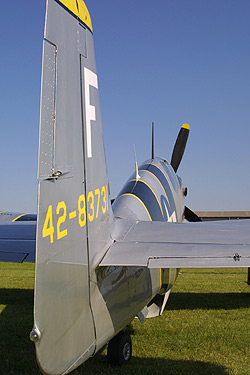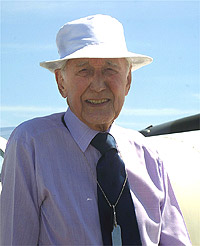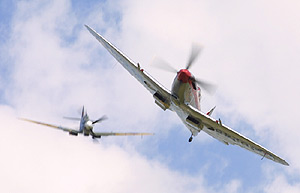 Aces
High!
Aces
High!
Gary Parsons samples the atmosphere at Duxford
This is how airshows are meant to be...warm summer days drenched in sunshine, puffy white clouds to form the perfect backdrop and spectacular flying to stir the soul. Legends more than made up for the cold of May's season-opener, and provided a feast of warbirds second to none 'this side of the pond'. Organised by The Fighter Collection, under the leadership of Stephen Grey, this year saw an unprecedented number of veteran pilots attending, including some of the most famous USAAF aces of all: Robin Olds, Don Strait and Gerald Johnson, all East Anglian based and returning to the fields where they made history. It was hoped that Robert Morgan, first pilot of B-17F 'Memphis Belle' and based at nearby Bassingbourn would make the trip, but family illness sadly prevented this.
|
Birthday
Ace
|
|
Brigadier General Robin Olds |
 |
|
The son of Major General Robert C Olds, who played an important part in the development of US Army Air Corps bomber tactics during the 1930s, Robin was born on 14 July 1922 during his father's service in Hawaii. With his family background, it is not surprising that Robin chose an Air Force career, attending the US Military Academy at West Point and receiving a commission as a Second Lieutenant in June 1943 and went to serve in World War II as a fighter pilot. He was assigned to the P-38 Lightning equipped 434th Fighter Squadron (FS)/479th Fighter Group (FG) in February 1944. The last of fifteen fighter groups sent to the Eighth Air Force in England, the 479th commenced operations from Wattisham, in Suffolk, in late May 1944. Robin Olds' first successes occurred on 14 August 1944, when he shot down two FW-190s that he had encountered at low level over France after becoming separated from his flight during a dive-bombing mission - these were the Group's only kills on this date. He was awarded three strafing victories four days later, and then on 25 August he became the 479th's first 'ace' when he downed a trio of Bf 109s over Rostock. One of only eight pilots to claim five or more kills in the P-38 with the Eighth Air Force, Olds was also the 479th's sole Lightning 'ace'. In September 1944, the Group converted to the P-51 Mustang and Olds claimed his first victory in his new Mustang on 6 October - a FW 190 - during an escort mission in the Berlin area. He was then starved of opportunities to add to his score until February 1945, by which time he had been promoted to the rank of Major. During the course of the month he claimed three Bf 109s and a FW-190 destroyed in the air and a Do 217 and another FW-190 destroyed on the ground. Continuing his success into March, Olds shot down a FW-190 and a Bf 109 on the 19th and was also made Commanding Officer of the 434th Fighter Squadron. Claiming his final aerial kill of the war (a Bf 109) on 7 April, he also damaged an Me 262 on this day. His final successes in Europe came nine days later when he was credited with five strafing kills during an attack on Reichersberg airfield. By the end of WWII, he had flown 107 combat missions, had twenty-four V2 combat kills, of which thirteen were air-to-air engagements, reached the rank of Major and commanded a squadron. Robin remained in the Air Force and was given command of the RAF's No. 1 Squadron (then equipped with Meteor IVs) during a six-month exchange tour in 1949. Having achieved the rank of Colonel in 1953, he returned to England again in August 1963 to take command of the 81st Tactical Fighter Wing (TFW) at Bentwaters in Suffolk, flying F-101 Voodoos until July 1965, when the wing converted to F-4C Phantom IIs. In 1966, when the Vietnam War had come to the front burner, he took command of the 8th Tactical Fighter Wing in Ubon, Thailand. He flew 152 combat missions in the Vietnam War, 115 of them over North Vietnam. He is credited with destroying two MiG 21 fighters and two MiG 17s. Robin Olds was promoted to Brigadier General in May 1968 and became the Commandant of the Air Force Academy at Colorado Springs. He retired in 1973. |
Mustangs abounded, the main theme being the 60th anniversary of the arrival of the USAAF to these shores in the Second World War. Bolstered by an early relative in the North American A-36A Apache, it was the largest gathering of P-51s yet seen in the UK. Shipped over from the United States especially for the show, A-36A 42-83731 is part of the Friedkin Family Chino Warbird Collection, and was making its debut on the UK scene.
 |
|
Alexander Adolphus Dumfries Henshaw was born on 7 November 1913, the son of a wealthy Lincolnshire businessman. Early in his life, he showed the courage and daring which were to stand him in good stead in his air racing and test pilot careers when he rescued a youth from a fast flowing river. For this, he was presented with the Royal Humane Society Award. He showed an early affinity for engineering and arrangements were made for him to take up an apprenticeship with Rolls Royce. Before starting his apprenticeship however, he worked for a time as a salesman for one of his father's businesses and proved so successful at this that he never took up his apprenticeship. His passion for flying began whilst he was still a teenager and he learnt to fly in a Gypsy Moth, soon acquiring a Moth of his own. At the age of only 19, he won the 1933 Kings Cup and began,his air racing career in earnest. In 1937, Henshaw acquired a Percival P6 Mew Gull and in 1938, won the, King's Cup with the fastest time of 236.25 mph. The following year, he concentrated his efforts on an attempt to beat the existing records for the point-to-point London to Cape Town flight. Henshaw flew from London to Cape Town, a distance of 6,377 miles, in 39 hours and 23 minutes, smashing the previous solo flight record by 39 hours and 3 minutes. It took him just 39 hours and 36 minutes to complete the return journey, again breaking the existing solo record by a staggering 66 hours and 42 minutes. In February 1940, Alex Henshaw married Barbara, Countess de Chateaubrun and Barbara, along with the Mew Gull and the Spitfire, were to be the three greatest influences in his life. It was also about this time that Henshaw met Jeffrey Quill, the Supermarine test pilot with whom he was to develop a close and lifelong friendship. When Quill offered Henshaw a job at Supermarine, he took it with alacrity and moved to Castle Bromwich as the Chief Test pilot. During his time there, from 1940-46, Henshaw flew over 3,000 aircraft from the Spitfire to the Lancaster. After the war, Henshaw worked for two years in Johannesburg as a Director of Miles Aircraft SA Ltd. On his return to Britain, he subsequently became involved in a range of family businesses. In 1953, he was cited for heroism for his part in the rescue of many members of his community when tide and storm surge conditions resulted in massive floods. Henshaw has written two books on his experiences - The Flight of the Mew Gull tells of his epic and record breaking flight from London to Cape Town and back in February 1939 and with his early life and experiences as a young aviator. Sigh for a Merlin deals with Henshaw's experiences as Chief Test Pilot at Castle Bromwich, the largest factory producing Spitfires and Lancaster bombers during the war. Now retired and living in Newmarket, Henshaw is a Past President of the Spitfire Society and, in 1997, was presented by HRH Prince Philip with the inaugural Jeffrey Quill Award for his services to aviation. Typical of someone who has lived life in the fast lane, Alex, at 89 years old, blasted off home after the show in his Audi Quattro! |
|
"General
Bill Kepner (of the Eighth Air Force) got us our P-51s and within
24 hours of their arrival we were on our first mission. Most people
have about 200 hours in a frontline fighter before taking it into
combat. We had about 30 minutes!"
|
|
Captain
Jim Goodson, 336th FS/14th FG, Debden, 1943
|
|
Mustangs!
|
 |
 |
 |
 |
 |
 |
 |
 |
 |
An extremely rare dive bomber version of the famous fighter, 42-83731 is one of only 500 built and the only one still flying. The A-36A first flew in October 1942 and the total production run was completed by March 1943. It was the first USAAF version of the 'Mustang' developed for Britain in 1940 and was originally given the name Apache, but was unofficially named 'Invader' by its pilots. A-36As were assigned to the 27th and 86th Bombardment Groups (Dive), later redesignated as Fighter-Bomber Groups. On 7 June 1943, the plane went into action from North Africa attacking targets on the island of Pantelleria in the Mediterranean between Sicily and Africa. During the Italian campaign, A-36A pilots flew bomber escort and strafing missions as well as ground support bombing attacks. A-36As also served with the 311th Fighter Bomber Group in India. Dive brakes in the wings gave greater stability in a dive, but they were sometimes wired closed due to malfunctions. In 1944, USAAF A-36As were replaced by P-51s and P-47s when experience showed that these high-altitude fighters, equipped with bomb racks, were more suitable for low-level missions than the A-36A.
Steve Hinton flew the Apache in several formations, first with the P-40 and later with Ed Shipley in P-51D 'Damn Yankee', showing the contrasting lines of the two types to good effect.
There were many British veterans present too, both human and those made of aluminium. A gathering of eight Spitfires and two Hurricanes paid homage to aces such as Pete Brothers, Thomas Neil and Robert Foster. Bomber colleagues were not forgotten too as the ARC's Blenheim performed, as did the BBMF's Lancaster. A 'Mercury trio' involving the Blenheim saw it formate with the Shuttleworth Collection's Gladiator and Lysander, the latter looking rather out of place in the summer sun with its all-black covert operations paint scheme!
The tiny Mew Gull, with its centre of gravity dangerously far to the rear under full fuel load conditions, was not an ideal aircraft for long distance record flight, being immensely cramped and uncomfortable as well as being demanding to fly. The cockpit was only two feet wide and just high enough to clear the pilot's head and the view forward was so poor that Alex Henshaw (see sidebar) devised a system of taxiing which involved walking beside the aircraft with the canopy open and his hand on the throttle!
|
Spitfires!
|
 |
 |
 |
 |
 |
 |
 |
 |
 |
G-AEXF was sold in 1939 and, after the war, was brought back to England from France where it had spent the war years. Unfortunately, the aircraft was damaged in an accident while landing and was then acquired by a Mr Fred Dunkerly. Subsequent modifications were carried out with the intention of improving forward visibility and the aircraft won the Kings Cup again in 1953 - albeit at a slower speed of 213 mph.
|
Hurricanes!
|
 |
 |
In 1975, the aircraft was acquired by Mr Desmond Penrose and, over a period of three years, he restored it to its original factory specifications. It has recently been acquired by the Real Aeroplane Company based at Breighton Airfield in Yorkshire and remains as an important part of Britain's aeronautical heritage. It flew in formation at Legends with Spitfires, in tribute to the amazing career of Alex Henshaw.
Much to savour
There was much else to see - in addition to the TFC's regular contributions the OFMC's Breitling Fighters performed their formation routine, B-17G F-AZDX 'Lucky Lady' joined 'Sally B' in gracing the sky (although they didn't quite formate together - damn!) and a whole host of Navy fighters supplied four and five-ship mini-balbos. With four F-4U Corsairs, two Bearcats, two Skyraiders, a Hellcat and Wildcat beating up the airfield, Charlie Brown and the pre-war Nimrod did the sensible thing and left them to it!
Legends proved that you don't need a polished display routine to entertain - just get five or six Mustangs in the air, beat up the airfield with some low passes and watch the grins on the faces in the crowd. Special mention must go to Maurice Hammond and Robs Lamplough who, in 'Janie' and 'Big Beautiful Doll' respectively, kept the crowd at the western end thoroughly entertained in fine 'beat 'em up' style. Top marks!
|
Legends
in their own way
|
 |
 |
 |
 The
final balbo flypasts mustered 31 aircraft out of a potential 33, a quite
remarkable achievement when you consider the age of some of these aircraft.
It's probably not so difficult to find 31 willing pilots, as many of them
are younger than the mounts they fly. When I win the lottery...
The
final balbo flypasts mustered 31 aircraft out of a potential 33, a quite
remarkable achievement when you consider the age of some of these aircraft.
It's probably not so difficult to find 31 willing pilots, as many of them
are younger than the mounts they fly. When I win the lottery...
All too soon it is all over. Our only grumble with Legends is that the flying display is too short at two and a half hours - we want more! But, the final words must go to Robin Olds, who when asked what he thinks when he sees so many P-51s in the air remarked "I'm right up there with them".


